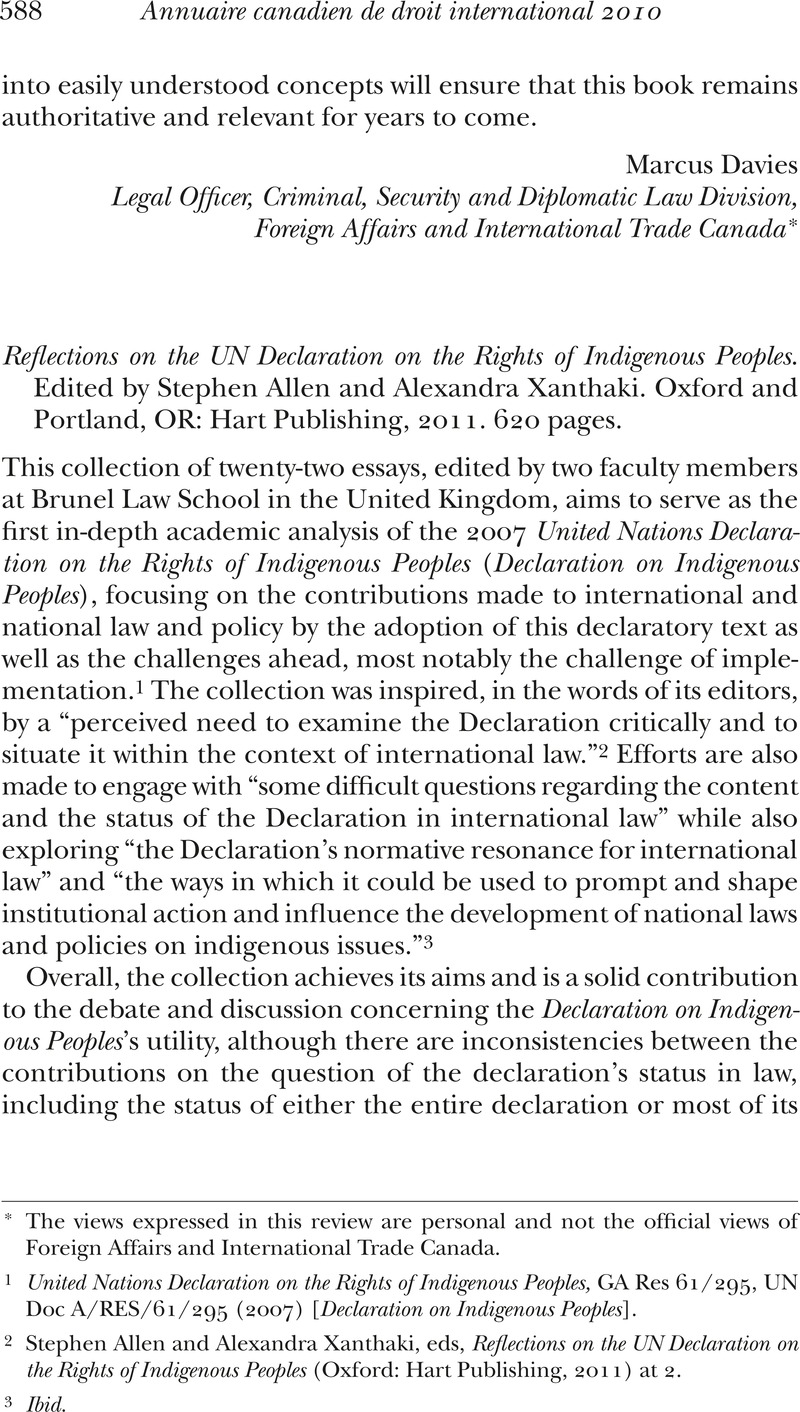No CrossRef data available.
Article contents
Reflections on the UN Declaration on the Rights of Indigenous Peoples. Edited by Stephen Allen and Alexandra Xanthaki. Oxford and Portland, OR: Hart Publishing, 2011. 620 pages.
Published online by Cambridge University Press: 09 March 2016
Abstract

- Type
- Book Reviews / Recensions de livres
- Information
- Canadian Yearbook of International Law/Annuaire canadien de droit international , Volume 48 , 2011 , pp. 588 - 594
- Copyright
- Copyright © The Canadian Council on International Law / Conseil Canadien de Droit International, representing the Board of Editors, Canadian Yearbook of International Law / Comité de Rédaction, Annuaire Canadien de Droit International 2011
References
* The views expressed in this review are personal and not the official views of Foreign Affairs and International Trade Canada.
1 United Nations Declaration on the Rights of Indigenous Peoples, GA Res 61/295, UN Doc A/RES/61/295 (2007) [Declaration on Indigenous Peoples].
2 Allen, Stephen and Xanthaki, Alexandra eds, Reflections on the UN Declaration on the Rights of Indigenous Peoples (Oxford: Hart Publishing, 2011 ) at 2.Google Scholar
3 Ibid.
4 As is well known, Australia, Canada, New Zealand, and the United States voted against the declaration’s adoption in the UN General Assembly on 13 September 2007. Beginning with Australia on 3 April 2009, followed by New Zealand on 19 April 2010, Canada on 12 November 2010, and the United States on 16 December 2010, all four opposing states have now expressed support for the principles found within the declaration, while reiterating that the declaration is a non-binding text. There are indications within the Allen and Xanthaki collection that Australia’s and New Zealand’s turn-around were known to the editors and contributing authors (see, for example, Allen and Xanthaki, supra note 2 at 123, n 4), but there is no specific analysis within the volume as to the impact of the about-face on the question of the declaration’s status in law.
5 Allen and Xanthaki, supra note 2 at 2.
6 An interesting counter-point is found in the preceding chapter by Julian Burger, the former head of the Indigenous Peoples’ Programme at the Ofice of the United Nations High Commissioner for Human Rights, who notes that the declaration has had little influence in the universal periodic review procedure with respect to either monitoring or recommendations for actions. Ibid at 56.
7 Some of the collection’s authors, such as Rodolfo Stavenhagen (at 151 ) and Javaid Rehman (at 584), anticipate the negotiation of a future convention, but the topic is not discussed in detail.
8 Universal Declaration of Human Rights, GA Res 217A (III) (1948).
9 International Covenant on Civil and Political Rights, 16 December 1966, 999 UNTS 171, Can TS 1976 No 47 (entered into force 23 March 1976).
10 International Covenant on Economic, Social and Cultural Rights, 16 December 1966, 993 UNTS 3, Can TS 1976 No 46 (entered into force 3 January 1976).
11 United Nations Declaration on the Elimination of All Forms of Racial Discrimination, GA Res 1904 (XVIII) (1963).
12 International Convention on the Elimination of All Forms of Racial Discrimination, 21 December 1965, 660 UNTS 195, Can TS 1970 No 28 (entered into force 4 January 1969).
13 Declaration on the Elimination of Discrimination against Women, GA Res 2263 (XXII) (1967).
14 Convention on the Elimination of All Forms of Discrimination against Women, 18 December 1979, 1249 UNTS 13, Can TS 1982 No 31 (entered into force 3 September 1981 ).
15 Declaration on the Rights of the Child, GA Res 1386 (XVI) (1959).
16 Convention on the Rights of the Child, 20 November 1989, 1577 UNTS 3, Can TS 1992 No 3 (entered into force 2 September 1990).
17 International Convention for the Protection of All Persons from Enforced Disappearance, 20 December 2006, UN Doc A/61/488 (2006) (entered into force 23 December 2010).
18 Declaration on the Protection of All Persons from Enforced Disappearance, GA Res 47/133, UN Doc A/RES/47/133 (1992).
19 See International Convention for the Protection of All Persons from Enforced Disappearance, Human Rights Council (HRC) Res 1/1 of 29June 2006, reprinted in Report of the Human Rights Council, UN Doc A/61/53 (2006) at 3–17.
20 Working Group of the Commission on Human Rights to Elaborate a Draft Declaration in Accordance with Paragraph 5 of the General Assembly Resolution 49/214 of 23 December 1994, HRC Res 1/2 of 29 June 2006, reprinted in Report of the Human Rights Council, UN Doc A/61/53 (2006) at 18–27.
21 The resolution concerning the indigenous rights declaration was adopted at the Human Rights Council by a recorded vote of thirty votes to two (Canada and the Russian Federation), with twelve abstentions (ibid) and at the UN General Assembly by a recorded vote of 143 (corrected to 144) votes to four, with eleven abstentions (UN Doc A/61/PV. 107 (2007) at 18-19). For further discussion, see Harrington, Joanna “Canada and the United Nations Human Rights Council: Dissent and Division” (2010) 60 UNBLJ 78 at 78–115.Google Scholar




